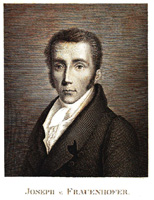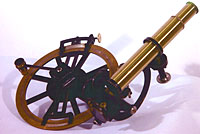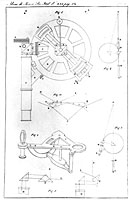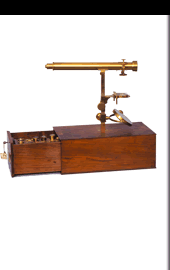Instruments
Prism reflecting circle
In his 1836 paper Descrizione di alcuni istrumenti da misurare gli angoli per riflessione < Description of various instruments for measuring angles by reflection > (download pdf), published in the “Memorie di Matematica e di Fisica della Società Italiana delle Scienze” (Vol. XXI-1837), Amici recounts the history of his navigation instrument. This history began in September 1820 when the attention of Baron Franz Xaver von Zach, who was visiting Amici’s workshop in Modena, was drawn to a small instrument for topographers and sailors. It functioned thanks to a combination of two glass prisms through the movements of which angles of up to 180° of two faraway objects could be measured. It was the first instrument that Amici had built in his efforts to overcome the limits of Hadley’s sextant and Borda’s reflecting circle, neither of which measured arcs beyond 120-130°. He was encouraged by von Zach to begin working on the instrument again, and two years later “Correspondance astronomique” published a description of his new Prism reflecting sector.
Former efforts to extend the use of these instruments by varying the position of the two mirrors or adding a third had not met with success. For this reason Amici came up with the idea of substituting the mirrors with prisms, and precisely with two rectangular isosceles prisms, one mobile on the alidade that bears the vernier, the other fixed to the plane of the graduated limb. The result was very gratifying, but the possibility of constructing other sectors and even full circles with larger prisms met with the insurmountable obstacle of finding clear, non-striated glass. The Baron helped him repeatedly by writing to Munich first to Utzschneider and then to Ertel. Fraunhofer replied on 16 October, 1824, after more than a year and a half of silence. He sent the requested glass, but he also firmly refused to furnish more in the future.
 Amici thus began looking at the traditional mechanisms of mirrors, in the hope of obtaining some improvement in their various arrangements. He discovered that just two mirrors placed over an entire circle instead of a sector offered some of the advantages he was looking for. Still in 1824 he created a circle that he called repeating circle and that he took with him, along with other instruments, during his trip in 1827 to Paris and London. In this latter city he was able to compare his instrument with a rough construction with two mirrors set at angles made by Troughton.
Amici thus began looking at the traditional mechanisms of mirrors, in the hope of obtaining some improvement in their various arrangements. He discovered that just two mirrors placed over an entire circle instead of a sector offered some of the advantages he was looking for. Still in 1824 he created a circle that he called repeating circle and that he took with him, along with other instruments, during his trip in 1827 to Paris and London. In this latter city he was able to compare his instrument with a rough construction with two mirrors set at angles made by Troughton.
The idea of having two flat mirrors rotate one over the other in order to measure angles was attributed by many authors to Caleb Smith, who had proposed an octant that was still named after him based on that principle. The same Smith had suggested that mirrors and prisms could be used indifferently for his instrument. Amici did not know of this in 1822 when he described his sector; he learned of it only in 1835. A letter from his son Vincenzo, dated 15 May, from Pisa, brought him the information he had requested about mirror and prism octants, and in particular about the octants of Caleb Smith and of Hadley. The information was taken from Astronomie des Marins, published in Avignon in 1766, which itself referred to another work which Amici had been looking for, Mémoires de Mathématiques et de Physique redigés à l’Observatoire de Marseille, published in 1755.
But at the same time he also realized that Smith “did not have in mind anything more than producing an analogous reflection in one way or another, and he did not discover the main property that prisms have of reflecting light even when the plane of reflection is parallel to the incident rays, the most important property of all, and one which I believe to have been the first to notice and recognize as useful for easily measuring angles from zero up to 180°” (Descrizione di alcuni istrumenti da misurare gli angoli per riflessione).
In the meantime in 1833 Karl August Steinheil of Munich invented a prism circle and had it constructed in Ertel. In the description of his instrument, published in the same year in the “Astronomische Nachrichten”, which Amici found to be very similar to his constructed in 1822, there is no reference to Amici’s circle. “However, one difference sets my instrument apart from that of Munich”, he wrote in his paper in 1836, “because in the latter the prisms are located one above and one below, whereas I proposed positioning them alongside each other. Do you wish to know why I chose to organize the prisms in this way? The reason is very simple, because that way they reveal objects twice as distinctly as seen in the reformed modern arrangement. In fact, a rectangular isosceles glass prism, if the incidental rays are, for example parallel or slightly inclined with reference to the reflecting plane, sends a band of light about as wide as a fourth of the hypotenuse to the objective which is in front of it. So if the two prisms are placed one over the other they are of no more use in transmitting light than is a prism alone, but if two prisms lie one alongside the other, two reflected luminous bands are produced, each with the same width of a quarter of the hypotenuse”.
 The Swiss astronomer Johann Kaspar Horner (1774-1834), while visiting the Baron von Zach in Genoa in 1822, had worked with and appreciated Amici’s reflecting sector. In a letter dated 20 February, 1833 Horner informed Amici as soon as Steinheil’s prism circle had come out of the Ertel workshop, and he offered his mediation to help Amici procure clear glass from the large manufacturers of Monte Jura.
The Swiss astronomer Johann Kaspar Horner (1774-1834), while visiting the Baron von Zach in Genoa in 1822, had worked with and appreciated Amici’s reflecting sector. In a letter dated 20 February, 1833 Horner informed Amici as soon as Steinheil’s prism circle had come out of the Ertel workshop, and he offered his mediation to help Amici procure clear glass from the large manufacturers of Monte Jura.
Only a few months later Amici received four large pieces of crown glass with no striae from the Widow Guinand manufacturer in Soleure. In this way he was able to begin working again on his former project and in 1836 he presented the public with the new prism repeating circle which can be seen photographed and in Figure 5.
The instrument, which Amici sent for free to the Sardinian Navy in Genoa, was judged very favourably by the Commanding Admiral, who expressed his desire of introducing the reflecting circle into His Majesty’s Navy in the place of the sextant. Based on his report, the Minister of War and Navy informed Amici on 22 August, 1836 that His Sardinian Majesty had conferred upon him the cross of the Knights of the Order of Saints Maurizio and Lazzaro in appreciation for the gift. It seems that many officers of the English Navy requested Amici’s circle as well, but the gratifying opinions remained mostly unheeded. The instrument was forgotten in Genoa until the times of Giovanni Battista Magnaghi. It was only temporarily reconsidered in 1847 by Ulisse Isola, Second Naval Lieutenant and Geometry professor at the Naval Academy of Genoa. He found it at the bottom of a wardrobe, “where it had practically always remained forgotten as is everything that does not come to us from abroad”. Intrigued, he wrote the constructor for instructions in using the instrument, which he intended to use during his next trip to the United States. There is no evidence, however, that there was any sequel to the matter.
 In the same way, there was no further known follow-up to the instrument sold to Reverend Robinson in 1837. On 16 November of that year, in Amici’s workshop account book there is an entry for thirty pounds for a prism reflecting circle sold to Mr. Robinson and Mr. Cooper, astronomers, who had paid 760 francs. Thomas Romney Robinson (1792-1882) was a Physics professor at Trinity College in Dublin and from 1823 Director of the Astronomical Observatory of Armagh in Ireland. As a member of the Astronomical Society and of the Royal Society of London, he took part in the ongoing campaign promoting magnetic research in the Antarctic regions. Among the various resolutions there was also that of promoting a research expedition in order to determine the position of the austral magnetic pole or poles. Two ships were prepared, the Erebus and the Terror, commanded respectively by James Clark Ross and by Francis Rawdon Moira Crozier. These were the same two ships which shortly after would take Sir John Franklin and Crozier on the disastrous expedition to find the North-West Passage.
In the same way, there was no further known follow-up to the instrument sold to Reverend Robinson in 1837. On 16 November of that year, in Amici’s workshop account book there is an entry for thirty pounds for a prism reflecting circle sold to Mr. Robinson and Mr. Cooper, astronomers, who had paid 760 francs. Thomas Romney Robinson (1792-1882) was a Physics professor at Trinity College in Dublin and from 1823 Director of the Astronomical Observatory of Armagh in Ireland. As a member of the Astronomical Society and of the Royal Society of London, he took part in the ongoing campaign promoting magnetic research in the Antarctic regions. Among the various resolutions there was also that of promoting a research expedition in order to determine the position of the austral magnetic pole or poles. Two ships were prepared, the Erebus and the Terror, commanded respectively by James Clark Ross and by Francis Rawdon Moira Crozier. These were the same two ships which shortly after would take Sir John Franklin and Crozier on the disastrous expedition to find the North-West Passage.
On 25 July, 1839, in a letter from Armagh, Robinson wrote Amici that his reflecting circle was on its way to the Antarctic: “You will be glad to learn that your circle is about to take its departure with Captain James Ross one of our ablest Nautical Astronomers who goes in command of the Magnetic expedition which the British Association have [sic] at length obtained from the Government. It can not be in more worthy hands”.
On 8 February 1840: “You have seen in the Newspapers that Captain James Ross has sailed on a Scientific Expedition and may remember that we destined your reflecting Prism-Circle for that distinguished Officer who as I had hoped was to sail at an earlier period. Well, he has got it with full instructions as to its management, and is to use it, not only for Lunar distances, but also for observations on low Refractions after a peculiar plan, observing the distance between the star near the horizon and one near the zenith, having the same Right Ascension. From this I am confident the superior powers of this Instrument will be laid before the Public most effectually, as Ross’s narrative from its very objects will obtain the most extended scientific circulation” (cf. A. Meschiari, Fisici e astronomi nella Corrispondenza di Giovanni Battista Amici. Sul circolo di riflessione a prismi nella spedizione antartica di James Clark Ross, “Atti del XX Congresso nazionale di Storia della Fisica e dell’Astronomia”, Napoli, 1-3 giugno 2000, CUEN, Napoli 2001 / A. Meschiari, Physicists and Astronomers in the Correspondence of Giovanni Battista Amici. On the Prism Reflecting Circle in the Antarctic Expedition of James Clark Ross, “Acts of the 20th National Congress of the History of Physics and Astronomy”, Naples, 1-3 June, 2000, CUEN, Naples, 2001).
 Giovanni Battista Magnaghi, Director of the Hydrographic Office of the Royal Marine and Captain of the Frigate carefully considered Amici’s prism reflecting circle, as he did the similar instruments of Borda, of Pistor and Martins, of Troughton, of Oertling and of Steinheil in his volume Gli strumenti a riflessione per misurare angoli (Instruments for Measuring Angles by Reflection), published by Hoepli in 1875. Under his direction, a “new Amici circle”, later known as the Amici-Magnaghi circle, was constructed in the workshops of the Hydrographic Office. It had in common with the original instrument “only the reciprocal position of the two prisms and of the telescope” (ibid., p. 202, but cf. also p. 25-27 and 61-71).
Giovanni Battista Magnaghi, Director of the Hydrographic Office of the Royal Marine and Captain of the Frigate carefully considered Amici’s prism reflecting circle, as he did the similar instruments of Borda, of Pistor and Martins, of Troughton, of Oertling and of Steinheil in his volume Gli strumenti a riflessione per misurare angoli (Instruments for Measuring Angles by Reflection), published by Hoepli in 1875. Under his direction, a “new Amici circle”, later known as the Amici-Magnaghi circle, was constructed in the workshops of the Hydrographic Office. It had in common with the original instrument “only the reciprocal position of the two prisms and of the telescope” (ibid., p. 202, but cf. also p. 25-27 and 61-71).
